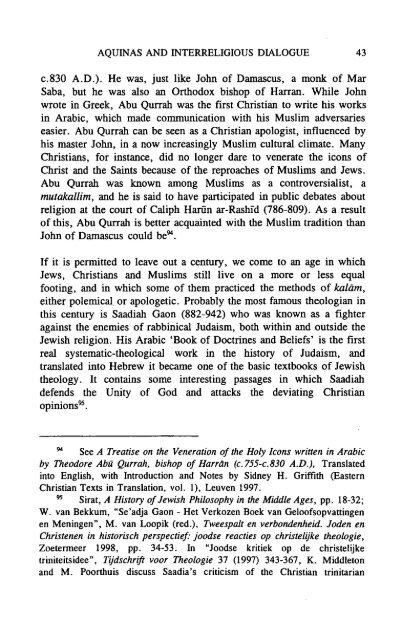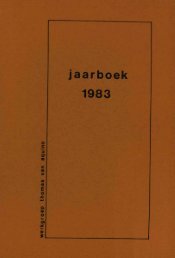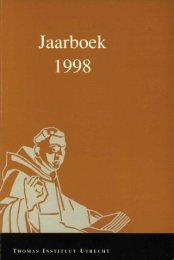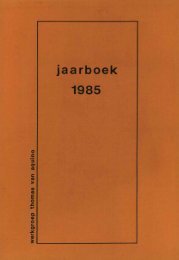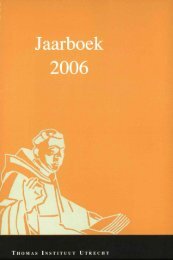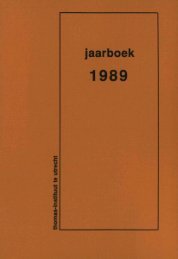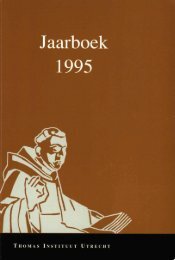Jaarboek Thomas Instituut 1997 - Thomas Instituut te Utrecht
Jaarboek Thomas Instituut 1997 - Thomas Instituut te Utrecht
Jaarboek Thomas Instituut 1997 - Thomas Instituut te Utrecht
Create successful ePaper yourself
Turn your PDF publications into a flip-book with our unique Google optimized e-Paper software.
AQUINAS AND INTERRELIGIOUS DIALOGUE 43<br />
c.830 A.D.). He was, just like John of Damascus, a monk of Mar<br />
Saba, but he was also an Orthodox bishop of Harran. While John<br />
wro<strong>te</strong> in Greek, Abu Qurrah was the first Christian to wri<strong>te</strong> his works<br />
in Arabic, which made communication with his Muslim adversaries<br />
easier. Abu Qurrah can be seen as a Christian apologist, influenced by<br />
his mas<strong>te</strong>r John, in a now increasingly Muslim cultural clima<strong>te</strong>. Many<br />
Christians, for instance, did no longer dare to venera<strong>te</strong> the icons of<br />
Christ and the Saints because of the reproaches of Muslims and Jews.<br />
Abu Qurrah was known among Muslims as a controversialist, a<br />
mutakallim, and he is said to have participa<strong>te</strong>d in public deba<strong>te</strong>s about<br />
religion at the court of Caliph Harün ar-Rashïd (786-809). As a result<br />
of this, Abu Qurrah is bet<strong>te</strong>r acquain<strong>te</strong>d with the Muslim tradition than<br />
John of Damascus could be".<br />
If it is permit<strong>te</strong>d to leave out a century, we come to an age in which<br />
Jews, Christians and Muslims still live on a more or less equal<br />
footing, and in which some of them practiced the methods of kalàm,<br />
either polemical or apologetic. Probably the most famous theologian in<br />
this century is Saadiah Gaon (882-942) who was known as a figh<strong>te</strong>r<br />
against the enemies of rabbinical Judaism, both within and outside the<br />
Jewish religion. His Arabic 'Book of Doctrines and Beliefs' is the first<br />
real sys<strong>te</strong>matic-theological work in the history of Judaism, and<br />
transla<strong>te</strong>d into Hebrew it became one of the basic <strong>te</strong>xtbooks of Jewish<br />
theology. It contains some in<strong>te</strong>resting passages in which Saadiah<br />
defends the Unity of God and attacks the deviating Christian<br />
opinions" .<br />
94 See A Treatise on the Veneration of the Holy Icons writ<strong>te</strong>n in Arabic<br />
by Theodore Abü Qurrah, bishop of Harrän (c.755-c.830 A.D.), Transla<strong>te</strong>d<br />
into English, with Introduction and No<strong>te</strong>s by Sidney H. Griffith (Eas<strong>te</strong>rn<br />
Christian Texts in Translation, vol. 1), Leuven <strong>1997</strong>.<br />
95 Sirat, A History of Jewish Philosophy in the Middle Ages, pp. 18-32;<br />
W. van Bekkum, "Se'adja Gaon - Het Verkozen Boek van Geloofsopvattingen<br />
en Meningen", M. van Loopik (red.), Tweespalt en verbondenheid. Joden en<br />
Chris<strong>te</strong>nen in historisch perspectief: joodse reacties op chris<strong>te</strong>lijke theologie,<br />
Zoe<strong>te</strong>rmeer 1998, pp. 34-53. In "Joodse kritiek op de chris<strong>te</strong>lijke<br />
trini<strong>te</strong>itsidee" , Tijdschrift voor Theologie 37 (<strong>1997</strong>) 343-367, K. Middleton<br />
and M. Poorthuis discuss Saadia's criticism of the Christian trinitarian


